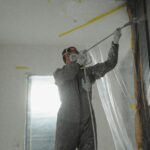Your home is your safe haven, which is why it’s always alarming when we hear about a new danger that could be lurking right under our noses — or, in this case: right in front of our eyes.
The dangers of lead paint aren’t anything new. In fact, an effort to limit the use of lead started back in the 16th-century. Mined for thousands of years, exposure to it has caused severe health issues for just as long.
Surprisingly, lead was still very much present in the average house paint until the 1970’s when concerns for the health and environmental risks of lead exposure became more widely known and it was determined that there is no safe threshold for exposure to lead. Congress banned the use of lead-based paints in residential buildings in 1971. By the 1978, the Consumer Products Safety Commission and the Environmental Protection Agency set further restrictions, banning its use.
Popular for its durability and opacity lead paint products were used in millions of homes across the US. If your home was built before 1978, it’s likely that there’s lead-based paint on the walls unless it has been professionally de-leaded. Even if your home has been painted more recently, it’s possible there are layers of lead-based paint hiding underneath newer coats of paint. And, unfortunately, simply painting over it won’t make it, or its harmful effects, disappear.
Is Lead Paint Dangerous to Be Around?
The good news is, so long as your lead-paint is in good shape, it’s not thought to be an active health hazard. However, if your lead paint is chipped or flaking, you may begin to experience the negative health effect of low-level exposure, a particular concern for children. The effects range from behavioral problems to learning disabilities, a significant risk to your family’s health and well-being.
Lead paint exposure during renovations causes an even greater risk. If you sand or remove old paint that contains lead, you will be experience direct exposure to it. Likewise, if the old paint is somehow crushed or otherwise becomes air-borne through small particles, even higher levels of exposure are likely.
How Do I Know If I Have Lead Paint?

The main question most homeowners ask when they begin to learn about the dangers of lead paint is obvious: How do you know if you have it? There’s no way to tell by simply looking at your painted surfaces. Instead, invest in a lead paint test kit. Do-it-yourself kits can accurately test for lead on most surfaces, but if you want to be absolutely certain, it’s best to call in a professional lead abatement contractor.
What happens if I paint over lead paint?
Painting over lead paint is not recommended. There is no way to “seal” lead paint in to make it safe. Especially if lead paint is chipped, flaking, or otherwise exposed, you may already be experiencing low levels of lead exposure. Your best course of action is to proceed with having the lead paint safely and properly removed.
If you live in an older home that has been recently painted or renovated, you’ll likely need to test for lead paint through the top layer. That’s because the original lead paint was likely painted over and remains on your walls.
Symptoms of Lead Exposure
There are two ways that lead exposure can happen. First, you may experience lead exposure after a short period of high-level exposure. This is particularly likely if you are re-painting a room that has remnants of lead paint. Your symptoms would include:
- Headaches
- Weakness
- Memory loss
- Abdominal pain
- Irritability
- Loss of appetite
If you experience any of these symptoms while painting or renovating, you should stop and consider the possibility of lead exposure.
The other form of exposure is low-level exposure over a long period of time. This leads to lead particulars accumulating inside the body, which causes:
- Abdominal pain
- Nausea
- Constipation
- Feeling distracted
- Forgetfulness
- Depression
- Irritability
It’s harder to realize low-level exposure because the changes happen gradually as the lead builds up in the body’s systems.
How Can I Remove Lead Paint?

If you suspect that lead paint is present in your home, it’s essential that you respond in the right way. Grabbing a paint scraper and begin removing paint yourself can actually increase the health hazard, causing particles to get into the air and even into your carpeting, furniture, and ventilation system.
If you want to remove lead paint safely, hire lead paint certified painters. These are professionals who have been specifically trained to identify and properly remove lead paint from older homes. Trained and licensed by the EPA, they follow a specific protocol before, during, and after the paint is removed, and have the necessary equipment to ensure that the rest of your home and the environment are protected, including HEPA filtered sanders, vacuums, and negative air machines.
Before hiring a professional, get clear estimates from lead paint certified contractors and be sure all lead-specific paperwork is in order before beginning work. While proper lead abatement is a specific and sometimes time-consuming process, once removed from your home, you and your family will breathe much easier knowing you have mitigated any health risks.






